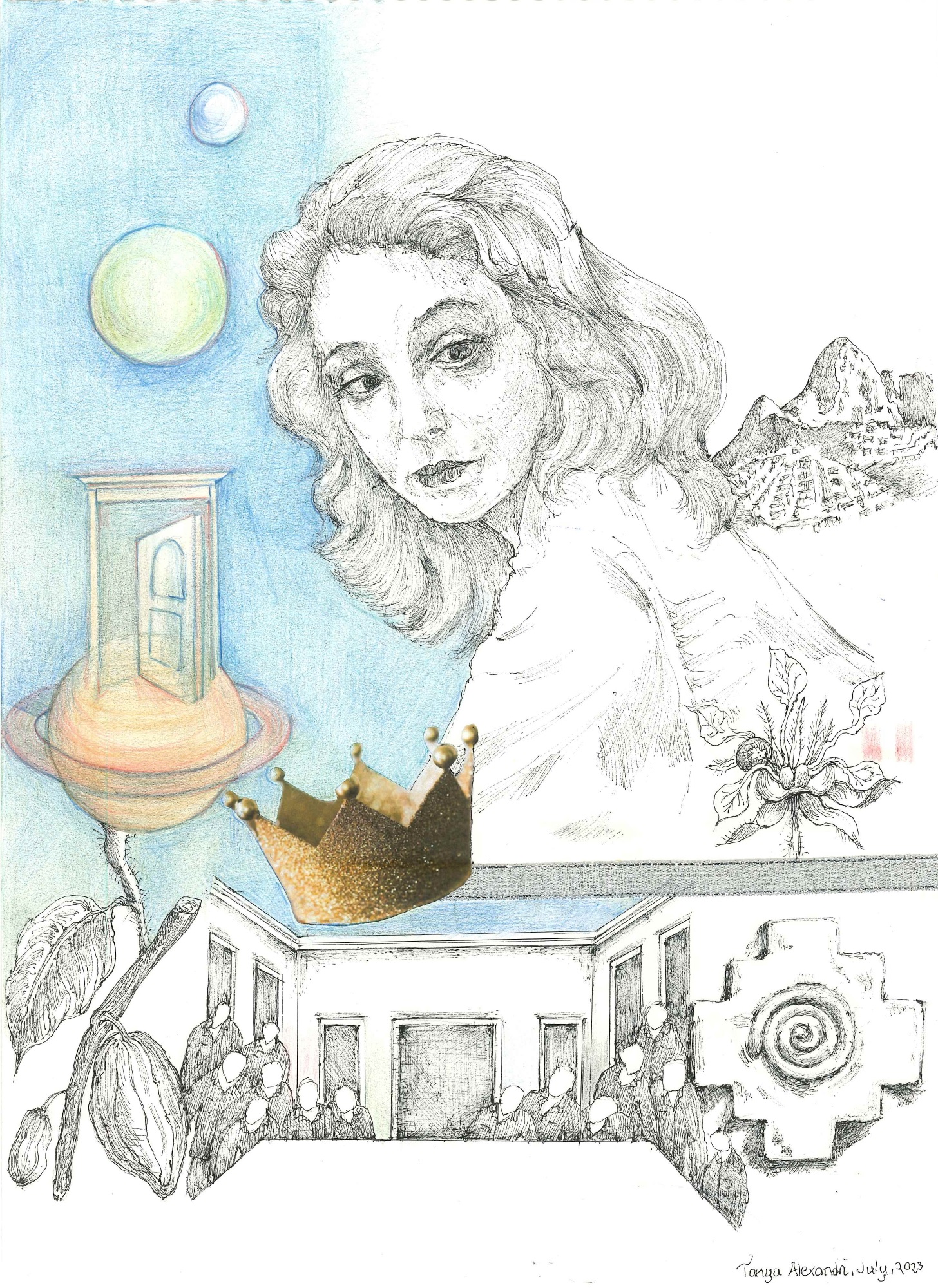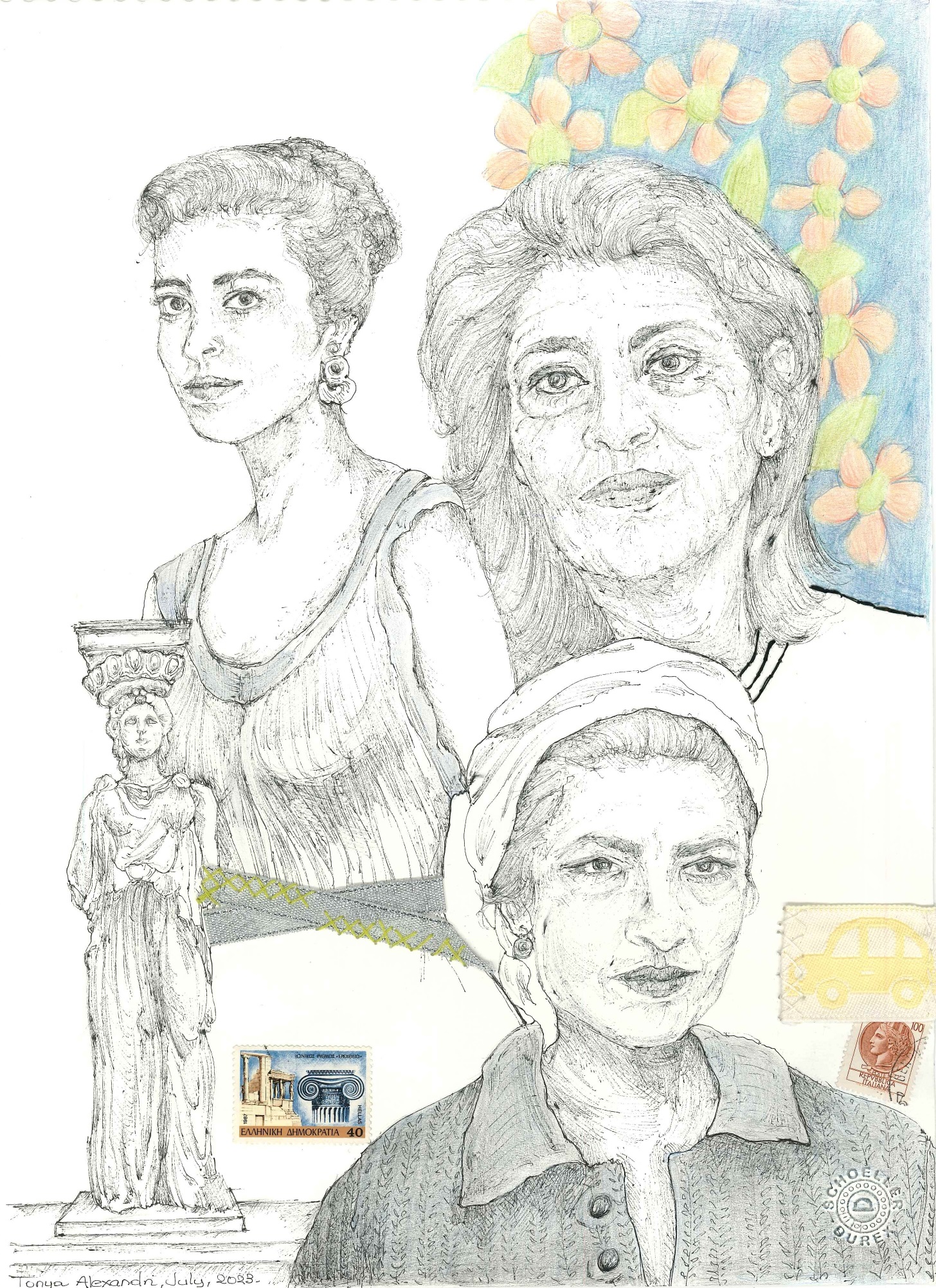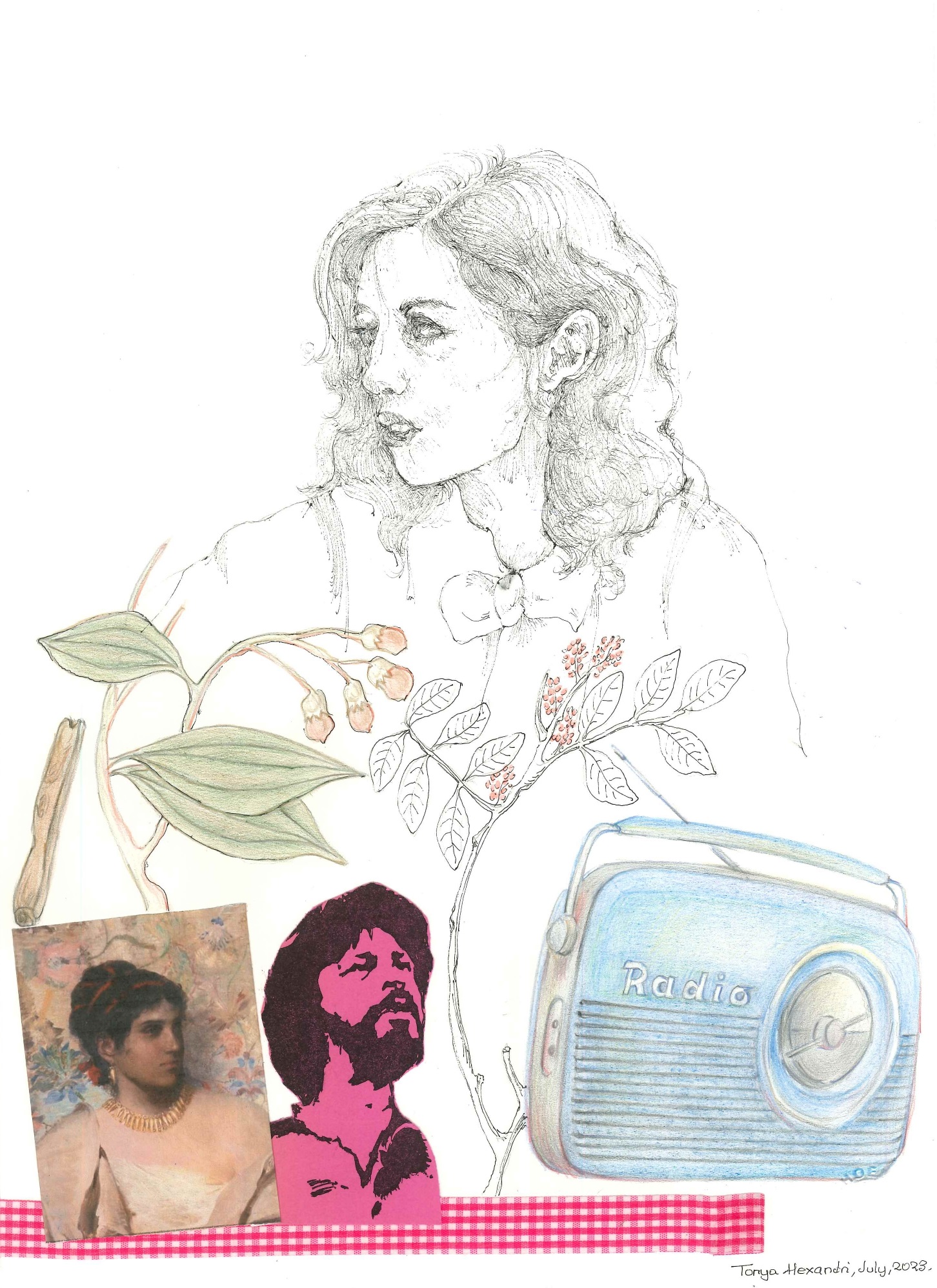July 18th, 2023
A biopsychosocial approach
“Much of each brain’s circuitry at any given moment in adult life, is individual and unique, truly reflective of that particular organism’s history and circumstances” Antonia Damasio
The infant who has attained calm attention has taken a first gigantic step on the road to fulfilment of her human potential” (Stanley Greenspan, cited in Mate)
“Although we think of attention as a function of the intellect, its deepest roots are in the subsoil of emotion.” Gabor Mate
Today’s post is about a book I’ve been reading by Gabor Mate: Scattered Minds: The Origins and Healing of Attention Deficit Disorder (2019). It also includes three new drawings inspired by Greek actresses of the past and a poem by late actress and poet Katerina Gogou.

Look how the roads get lost by Katerina Gogou (1981)
Look how roads get lost / within humans
how cold the kiosks get / from the wet newspapers how the sky / is punctured by the cables
And how the sea ends / from the weight of the ships
how sad the forgotten umbrellas stand / on the last ride
And the mistake of the one that got off / at the wrong stop
the clothes left at the drycleaner’s / and your shame
after finding the money two years later / to ask for them
how little by little / gradually, methodically / they shape us
so that we determine our position in life / depending on the style of the chair


Gabor Mate is a retired physician, writer and speaker. His analysis in this book is, according to his own words, an attempt to synthesize the findings of neuroscience, developmental psychology, family systems theory, genetics and medical science, cultural and social trends and his own personal experience as a husband, parent and successful and respected family doctor, who was diagnosed with ADD in his fifties. His three children have also received the diagnosis. Before I go on I’d like to say that I think that the book could also be read as an example of how to avoid simplistic explanations and how to apply a more holistic biological and psychosocial approach to analyze and explore many facets of human experience.
A great part of the book is an exploration of the contributory factors. In the introduction Mate states that he believes that it is not, as often stated, a matter of genes or bad parenting; however, both genes and parenting play a role. He believes that there is in ADD a predisposition [making it more likely depending on circumstances], not a genetic predetermination. He states that as many other things genes can be activated or turned on in the environment, but there can also be protective factors in the environment. He explains that although diabetes is considered to have a heredity component this cannot account for the pandemic among Canada’s native people and North American populations, for instance. He also discusses problematic aspects of research findings in twin studies. He writes: “Neuroscience has established that the human brain is not programmed by biological heredity alone, that its circuits are shaped by what happens after the infant enters the world, and even while it is in the uterus. The emotional states of the parents and how they live their lives have a major impact on the formation of their children’s brains, though parents cannot know or control subtle unconscious influences.”
Broadly speaking the major features of ADD are poor attention skills, deficient impulse control and hyperactivity. Mate describes how this higher level of distractibility can foster chaos and lack of order both in our lives and physical spaces. However, he clarifies that absentmindedness [and all other manifestations of ADD] are on the continuum of normal human traits and life would not be possible without our being able to shut out a large number of stimuli. Also, ADD can be situational, which is interesting and important to consider, especially, for students in educational contexts. Distractibility may not be consistent in all areas or subjects and one can have a hyper concentrated attention when it comes to subjects and activities they’re interested in or when the environment is conducive to learning.
In chapter 14, distractibility is discussed in relation to natural defenses and responses like fight- fight-freeze and dissociation and what happens when an infant through chronic distress and non optimal experiences needs to resort to these too often. Mate writes the infant cannot exist in a state of chronic negative arousal with adrenaline and other stress hormones pumping through its veins all the time, it needs to block it out, but the survival value of these psychological defenses are short lived. If this happens too often it becomes the default setting in the cerebral apparatus of awareness. Mate writes that nobody is born with “attention” and that being attentive is a skill like language or locomotion that children acquire through their relationship with the environment.
Hyperactivity is unregulated high arousal, appropriate in the young toddler. However, it is meant to be a stage and not a state that the child gets stuck in. Mate claims that throughout our life it continues to be a human response during times of high anxiety, but again it’s not meant to be a constant state. It is usually expressed by difficulty keeping physically still, but can also take forms that are not obvious to the observer, and it is not a requirement for diagnosis. He claims that it may be absent in a minority of cases, especially in girls. He writes that people with ADD experience their mind as a perpetual motion machine. They may have an intense aversion to boredom and higher levels of procrastination. Other manifestations of ADD might be rapid speaking, hopping from one topic to the other, and difficulty being succinct and brief when expressing an idea.
In chapter 5 Mate explores another feature that might be present, which is time illiteracy or what others have termed as time blindness and which can be a source of distress for people with ADD. This could involve always being late and rushing, believing one has all the time in the world and not being able to calculate the time required for an activity or living as if only the present exists and nothing else needs to be taken into account, often neglecting to consider the consequences of actions. The chapter also focuses on poor emotional regulation and impulse control and presents the neuroscience behind impaired ability in these areas. For instance, a major task of our prefrontal cortex is inhibition – the evaluation and selection or inhibition of the myriads of sensations and impulses reaching it from the environment, our body and lower brain centers.
Mate asserts that in ADD the cortex is functioning at a semidormant level, which explains the use of stimulant medications. He also clarifies that a complex condition like ADD cannot be traced in one part of the brain and in a later chapter he discusses the implication of specific areas like the orbital prefrontal cortex (OPC), which among other things is the centre of the brain’s reward and motivation apparatus and is also connected with the vision centers of the cortex that play a role in visual spatial orientation mentioned above. He describes his own difficulty conceptualizing in three dimensions or divining the spatial relationship of things. The OPC also stores the emotional effects of experiences, and first and foremost, the infant’s interaction with primary caregivers, which become an unconscious model for all our later emotional interactions, for better or for worse, until we can become aware of and disrupt the patterns.
Mate uses vignettes from patients, friends and his own experience to describe what living with ADD might feel or look like for different people. As I read through the book I could not help thinking that there was an overlap between what was described and discussed here and other diagnoses like post traumatic stress or other clusters of symptoms / experiences, and that maybe ultimately, our priority should be the healing, resolving or managing of whatever experience or cluster of characteristics people present with that are causing them problems, discomfort or difficulty in living more optimally, especially, in our contemporary societies. As I mentioned above, I felt that a lot of what is discussed in the book goes beyond ADD and provides a holistic perspective of examining or viewing our human experience.
Early on in the book Mate critiques the DSM for defining ADD for its external features, which are referred to as symptoms, not the emotional meaning in the lives of those that experience it because as he notes “The DSM is concerned with categories not with pain” (Dan Siegel). He also writes that what begins as a problem of society and human development has become almost exclusively defined as a medical ailment. He points out that even if in many cases medication can help, especially for a certain period, the healing that the ADD experience calls for is not a process of recovery from some illness. He suggests that “ADD defies categories of normality and abnormality. If anyone who exhibits any trait of it were to be diagnosed with ADD, we might as well put Ritalin in the drinking water…” and that learning about the psychological and biological mechanisms of ADD only gives a map to the self, but the map is not to be confused with the journey. Our aim should be once we recognize this map to support the child, for instance, to fulfill its potential.
In chapter 3 Mate refers to the skepticism about ADD and the actual prevalence of ADD because all features of ADD are found to one degree or another in the non ADD population, and that lumping a group of personality features in a psychiatric manual does not establish pathology. He quotes L.J. Davis who writes in relation to current psychiatric diagnostics and manuals that “every aspect of human life (excepting of course the practice of psychiatry) can be read as pathology.” In relation to “the spreading like wildfire fire” diagnosis of ADD mostly in countries like Canada, Northern America and the UK, Mate asks the question: Are children being drugged to suit the convenience of adults?
He writes; “Even for those, such as myself, who recognize the existence of the neurophysiological and psychological impairments conjointly named Attention Deficit Disorder / ADD, there are legitimate questions to be asked about the way it is diagnosed, how it should be understood and about its treatment, as well as, the tendency to bury many problems under tons of medications, preferring to ignore the social and cultural causes of people’s stressed mental states, and the blaming of shortcomings or problematic experiences on biology and chemical imbalances. Therefore, it is important to wonder about the reasons there is so much emphasis on biological explanations and oversimplification of complex processes, and also, to realize that we need to tease apart layers of causality and dig below the presenting neurochemistry, for instance. Mate quotes Dan Siegel who has remarked “We hear it said everywhere these days that the experience of human beings comes from their chemicals.”
As I said a big part of the book is devoted to exploring the causes that can contribute to or turn on any inherited predisposition for ADD. Through his personal narrative Mate points to the environmental roots of attention deficits and to the fact that love is not enough when parenting. In chapter 4 he writes about how unexpressed emotional conflict and unresolved grief and ignorance can result in unintentionally passing down from generation to generation less than optimal experience. He is candid about his own workaholic tendency, distractedness, feeling of duty towards the whole world, intense need to be liked, all of which provided him with a constant adrenalin rush, but had a negative impact on his family. He situates himself in relation to dynamics in his own marriage and family life, to show how despite the love unresolved traumas and conflict of parents can have a less than optimal impact on their children, and also, how through a lot of hard work and new awareness his family was able to navigate this and be at a different place today.
Also a significant perspective presented by Mate in the book is the importance of viewing the ADD experience through developmental lens because as he claims once we recognize ADD as a problem of development (arrested in younger modes of functioning) rather than pathology, we are taken to a different direction from the illness model. For instance, hyperactivity is a normal stage of maturation of a child, but in ADD stages become states. When we recognize that time sense, self regulation and self motivation, for instance, are nature driven developmental tasks we can ask more appropriate questions like:
What conditions are needed for human psychological and physiological maturation and what conditions could inhibit or interfere with this growth process?
Mate cites child psychiatrist Stanley Greenspan who says “So few children grow up in truly optimal circumstances that we have no idea of what the parameters of development really are.” The concentration of developmental problems may be both due to circumstances and to the fact that people are affected differently by similar conditions depending on their sensitivity level and temperament. Also, he reminds us that no two siblings grow up in the same environment since circumstances and parents change. In addition, we need to take into account that often parents have different unconscious attitudes towards each of their children and that siblings experience their parents differently.
There’s a chapter in the book on sensitivity, in which Mate explains that what is transmitted genetically is not ADD, but sensitivity and that the existence of sensitive people is an advantage to humankind because it is this group that best expresses humanity’s creative urges and needs. Mate claims that there would be valid and powerful evolutionary reasons for the survival of genetic material coding for sensitivity, and therefore, it is not a weakness or disease that is being inherited but a trait for intrinsic survival value to human beings. Furthermore, it has been observed that people on the continuum of ADD can have strengths like creativity, curiosity, conversational skills, high energy, hyper focus, spontaneity, nonconformity and resilience. They can be imaginative, inventive and resourceful.
In chapter 8 Mate analyses how basically the microcircuitry of the brain is formed by influences during our early years and that even the brains of identical twins will differ in terms of the shape of their nerve cells or the numbers and configurations of their synapses. He explains how our genetic potential for brain development can find its full expression only if circumstances are favorable. He describes what a favorable environmental for an infant might require. Apart from nutritional needs and shelter requirements, a secure safe and not too stressed emotional atmosphere is also necessary [which he notes is most likely to be disrupted in Western / industrialized societies] in order for the maturation of the human brain and nervous system to take place. He writes that one significant reason for the disturbingly high prevalence of ADD conditions in Western countries, especially, in North America, is the gradual destruction of family by economic and social pressures. He quotes Hallowell and Ratey to suggest that culture can feed and reinforce ADD and make ADD driven behaviours seem desirable and rewarding.
This chapter leads on to the next on attunement, which is the component of a larger process called attachment, which is essential for survival. The drive for attachment is part of the very nature of warm blooded animals in infancy, especially of mammals. Mate interestingly notes that ADD may equally stand for Attunement Deficit Disorder and that “attachment promotes attention, anxiety undermines it.” He highlights the fact that one-to-one attuned parenting is the ideal situation for child development in the early years, something which is not supported in most industrialized (Western) societies. He clarifies that the need of the young child for close parental contact does not mean the ghettoization of women at home. He also describes how he has made sense of his ADD traits in the light of his own early years and how being separated from his own mother for a short period of time as a newborn during the World War II impacted him and his mother. He adds that we don’t need a war and genocide for mothers to be stressed out and fathers to be absent or for women to be burdened with the full responsibility for the family’s emotional well being or for trauma to have occurred.
“The generations are boxes within boxes…”
Chapter twelve delves into intergenerational dynamics and how both positive and negative experience is passed down from one generation to another. He writes: The family as an institution has been put under enormous strain by vastly powerful forces in our society and culture. If we want to find the source of ADD that is where we need to look, but the family is the most immediate environment to act on us…. He concludes that in order to understand ourselves and our childhoods, we need to consider the positive and negative effects that our grandparents’ unconscious processes, attitudes, behaviours and circumstances had on our parents. When we do this we eventually realize that blame becomes meaningless and what is more important is the making sense of our experiences and the disruption of patterns.
To conclude, the second part of the book is focused on the possibilities of healing or growing out of ADD. However, I will end the post because it has evolved into a lengthy narrative.
